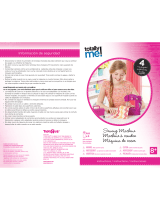
6
WINDING THE BOBBIN
1. Always remove the bobbin (S) from the bobbin case on the machine before you wind a
new bobbin.
2. Place the thread spool (E) on the thread spindle (C)
3. Put the bobbin pin into the hole on the hand wheel and turn it slightly anti-clockwise.
4. Take an empty bobbin and in one hand pull the thread down from the thread spool (E)
and thread the loose end through the small hole on the bobbin rim from the inside.
5. Leaving the loose end on the outside of the bobbin, wind the thread several turns around
the inside of the bobbin.
6. Place the bobbin on the bobbin pin, making certain that the thread is winding onto the
bobbin in an anti-clockwise direction.
7. Hold the thread lightly guiding it through your thumb and index finger.
8. When the bobbin is full, switch the machine off. Insert the bobbin into the bobbin case
using the instructions for threading the machine.
SAFETY INFORMATION
• Always disconnect or remove the power supply (including batteries) when changing
needles or threading machines.
• Never open the main motor case of the machine. The mechanism has been factory
adjusted.
• Always check the threading of the lockstitch before beginning to sew a seam. Improper
threading or placement of the bobbin in the case will result in damage to the machine.
• Do not pull on the fabric. Pulling could break the needle and result in damage to the
machine.
• Remove batteries when the machine is not in use for long periods. This saves battery life
and protects the machine. Keep extra batteries on hand so projects will not be
interrupted when batteries need replacing.
• KEEP AWAY FROM CHILDREN: This sewing machine is not a toy and is not meant to be
used by or near children.
• The sewing machine is an electrical appliance when used with the adapter. Do not
submerge the unit or any other parts in water. Do not operate the sewing machine with
wet hands, without shoes, or while standing in water, or on a wet surface.
• Do not change needles or thread the machine while the unit is on. Do not touch the
needles before the power is turned off.
• Never use the machine with a damaged power cord or plug.
• Keep the power cord away from heated surfaces.
• Do not close a door on the cord or pull around sharp edges as this could cause the cord
to become punctured or damages and could result in injury.
• Do not unplug by pulling or tugging the cord. Grasp the plug with dry hands to remove
from the outlet.
• Do not sew clothing while it is on your body.
• Use only the power adapter supplied.
• Never leave the sewing machine unattended while plugged in. Turn the switch off and
unplug the cord when not in use.
• This appliance is not intended for use by persons (including children) with reduced
physical, sensory or mental capabilities, or lack of experience and knowledge, unless they
have been given supervision or instruction concerning use of the appliance by a person
responsible for their safety. Children should be supervised to ensure that they do not play
with the appliance.
•
Check the power cord for damage each time the machine is used. Damaged power cords
should be replaced immediately and may never be re-used.









